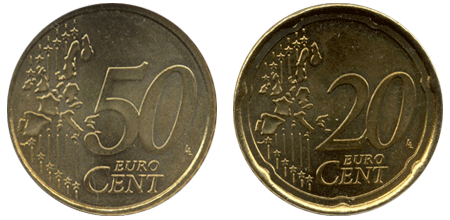Glossary
CategoriesBonded CoinsBroadstrikes Brockages Counterbrockages Die Adjustment Strikes Die Caps Die Trials Double Denomination Double/Multiple Strikes Dual Countries Dual Mint Marks Essay Trial Strikes Experimental Blanks Experimental Strikes Experimental Surface Feeder Finger Strikes Foreign Coins Struck on U.S. Planchets Galvanos Gold Die Trials Gold Errors Gold Off-Metals Hub Trials Indents Intentional Errors Martha Washington Test Pieces Mated Pairs Mules Multiple Errors Off-Centers Off-Metals Overstrikes Pattern Die Trials Pattern Errors Pattern Mules Plaster Models Platinum Errors Proof Errors SMS Mint Errors Specimens Spectacular Errors Struck Scrap Struck Thru Transitional Errors Two-Headed Coins Two-Tailed Coins Uncancelled Dies Uniface Die Trials Unique Coins |
 Euro 50 Cent/20 Cent Mule MulesAn example would be a New Zealand/Bahama mule where thousands were struck and they are worth $50 each. The obverse of a Bahama 5 Cent piece was muled with the reverse of a New Zealand 2 Cent piece. On the other end of the spectrum are the extremely rare mules including a few from the United States. An example would be a mule with a Sacagawea Dollar reverse and a State Quarter obverse. The photo shown above is a rare example of a Euro 50 Cent reverse that was muled with a Euro 20 Cent reverse. This rare piece is also a "two-tailed" coin because both dies were reverse designs and both are denominations of Euro coinage. |



